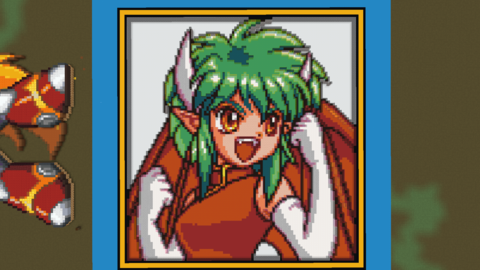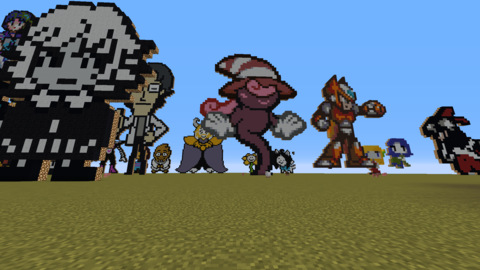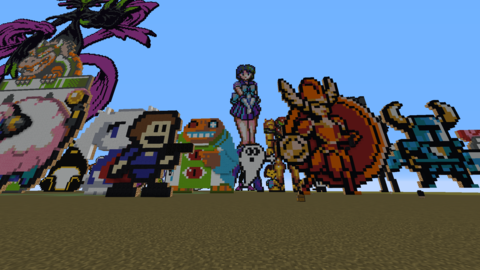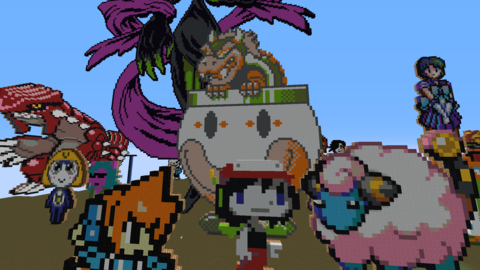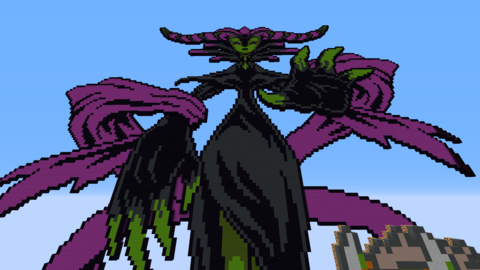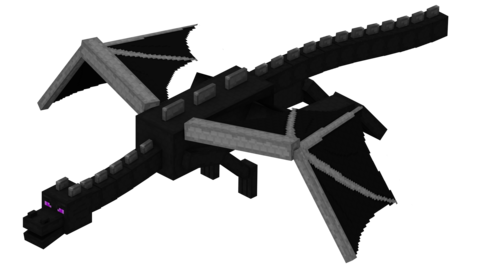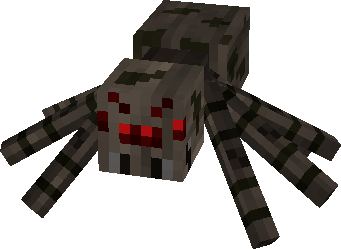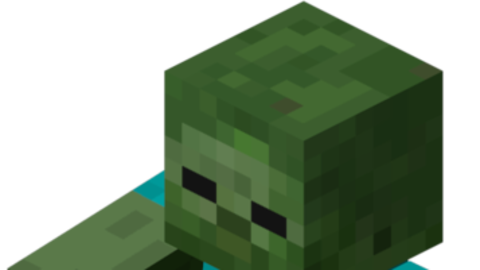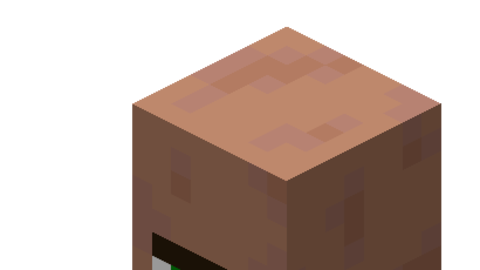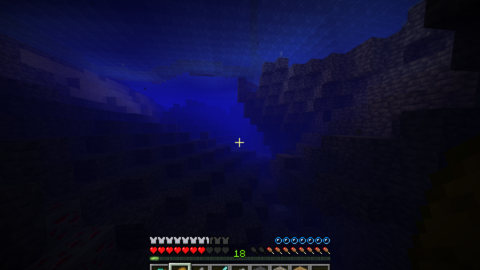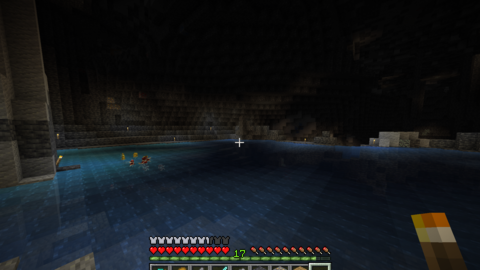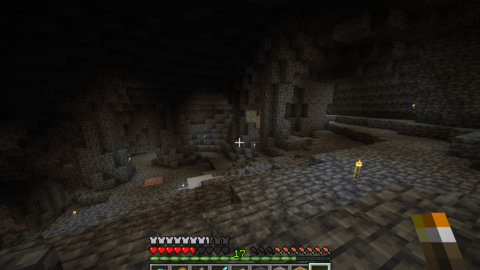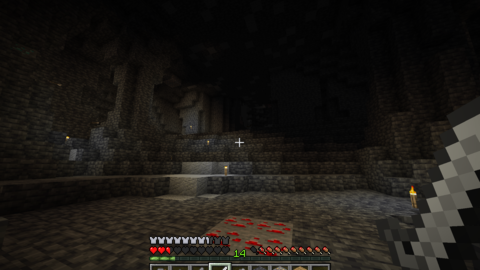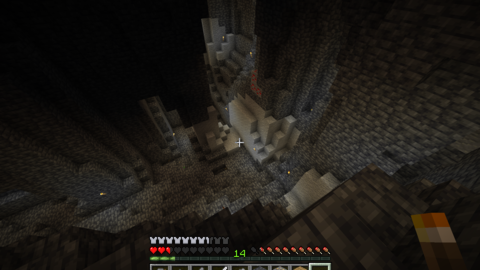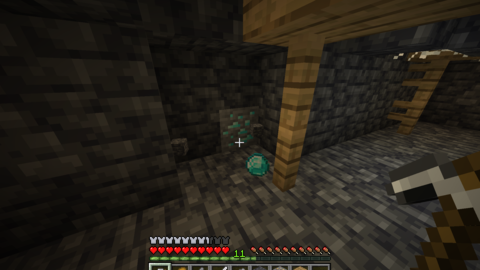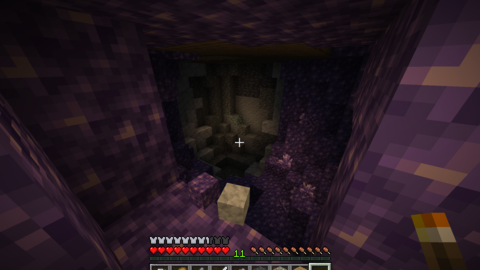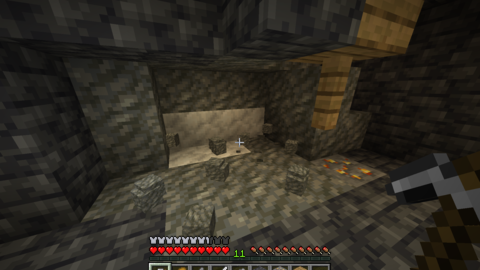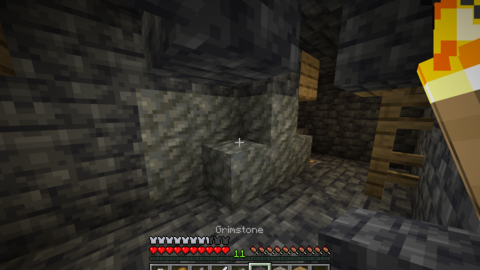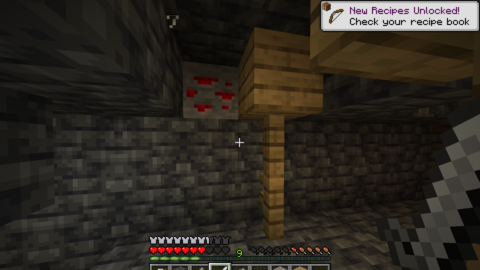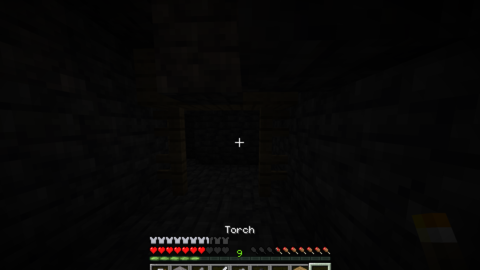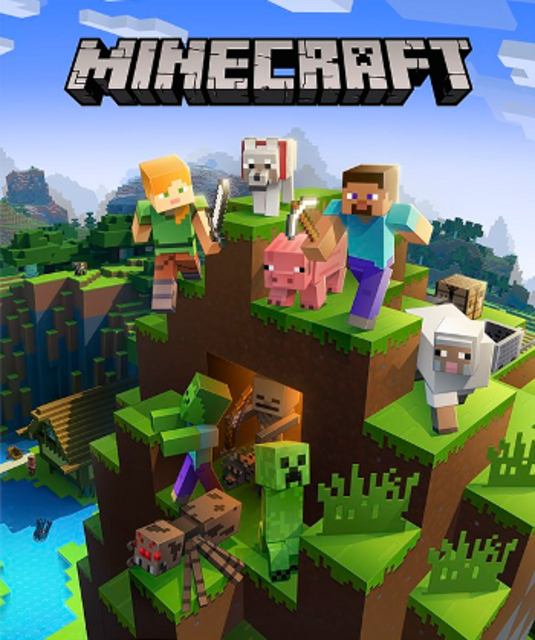Overview
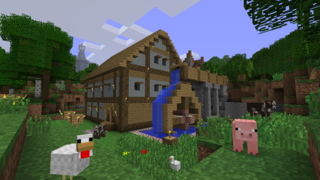
Minecraft is an open world, first-person, survival sandbox game, developed and published by Mojang. It was originally released in a pre-alpha state via the TIGSource forums on May 17, 2009, and was later hosted online for supported browsers before receiving a standalone release for PC, Mac, and Linux on June 30, 2010. The game would officially exit its Beta version on November 18, 2011, although major updates continue to be released. Since August 2011, a number of ports of the game have released for consoles and mobile devices.
Presented with a unique low-resolution "voxel" aesthetic (where everything is shaped using cubes), the game allows players to interact with a variety of different "blocks" in a procedurally-generated world. Along with both resource mining/gathering and item crafting (hence the game name), the game features exploration (with multiple biomes and locations), combat, and construction. In addition to the standard "Survival" mode, the game features a "Creative" mode that allows players to design environments with an unlimited amount of blocks at their disposal and no survival elements. The game supports online multiplayer and later supported numerous content packs (including new world/block textures and player skins, many of which are cross-promotions with other games and franchises).
Originally created by indie developer Markus "Notch" Persson (whose roles were later taken over by fellow indie developer Jens "Jeb" Bergensten), Minecraft was ported to numerous smartphones (originally known as Minecraft: Pocket Edition) and consoles (originally known as Minecraft: Console Edition, with the "Console" in the name being replaced by the console's name). On September 20, 2017, the game received a major "Better Together" update that merges the smartphone version with some console versions (including Windows 10, Xbox One, and later Nintendo Switch) together for a single multi-platform version (known as Minecraft: Bedrock Edition, with the original computer versions renamed to Minecraft: Java Edition) with all features accessible (including cross-platform multiplayer). Alternate editions include a multi-platform version for use in classroom settings (Minecraft: Education Edition), a cut-down version for small Raspberry Pi microcomputers (Minecraft: Pi Edition), and a multi-platform version for use in China (Minecraft China).
The game has received a number of spin-offs, including the 2015 adventure game Minecraft: Story Mode (and its 2017 sequel), the 2020 dungeon crawler Minecraft: Dungeons, and the augmented-reality mobile game Minecraft Earth. As well, Minecraft's procedurally-generated sandbox elements would inspire many other games, in both 2D (such as Terraria and Starbound) and 3D (such as Dragon Quest Builders and LEGO Worlds).
Versions
Original / Java Edition
The original version of Minecraft, developed using a custom engine in Java, had three major pre-release phases: pre-Alpha (including Classic, Indev, and Infdev), Alpha, and Beta. Almost every version of the Java Edition can be played in the final release via the launcher, including some versions originally not released to the public.
- Classic: The first of the pre-Alpha versions, Classic versions were first released for free for supported browsers on May 17, 2009, lasting until November 10, 2009. These versions originally lacked survival elements (instead being a primitive version of the modern "Creative" game mode), and had a restricted, randomly-generated environment (surrounded by endless ocean). Online multiplayer was added on May 31, 2009, and an alternate single-player version with basic survival elements (such as enemy mobs, a health system, and a basic bow-and-arrow system) was added on September 1, 2009.
- Indev: Short for "In-development", indev was the second phase of the pre-Alpha versions, beginning on December 23, 2009 and lasting until February 23, 2010. Indev focused on the "survival" version of the game introduced in Classic, and added a new dynamic lighting system, crafting and inventory systems, optional map themes, specialized tools and weapons, a day-night cycle, and farming.
- Infdev: Short for "Infinite Development", infdev was the final of the pre-Alpha versions, beginning on February 27, 2010 and lasting until June 30, 2010. The name infdev was chosen as these versions revamped the terrain generator, allowing for "infinite" procedurally-generated terrain. In addition, this version adds more craftable items (including signs, ladders, doors, and minecarts) and more complex cave systems (including special dungeons).
- Alpha: Beginning on June 30, 2010 and lasting until December 3, 2010, the alpha versions were the first version to allow (and require) a paid, standalone launcher to play, rather than being playable for free in-browser. These versions added biomes, redstone circuitry, improved A.I. pathfinding, new block types (including stairs), and a new dimension (The Nether), alongside reintroducing online multiplayer. Most updates in this time were added as "Seecret Friday" updates, which intentionally left the changelog empty to let players find out what's changed.
- Beta: Beginning on December 20, 2010 and ending on November 11, 2011, the beta versions added numerous block and mob types (including beds and tame-able wolves), revamped the inventory system (making it easier to control and more difficult to cheat items in), and added weather effects and achievements. One of the last major updates (also called the "Adventure Update", released on September 14, 2011), revamped the game's biome generation while adding new combat mechanics (such as critical hits), an experience system, a hunger system, sprinting, and new pre-generated structures (such as villages). The Adventure Update also introduced a new Creative Mode, based loosely upon the original Classic verion of the game, albeit with a variety of new features.
- Full Release: Starting on November 18, 2011 with the 1.0.0 version of the game, the full release of Minecraft introduced an ending, including a new dimension (The End), a final boss (the Ender Dragon), and a credits sequence. Updates since version 1.0.0 have added another boss (the Wither), rebalanced the combat system, greatly expanded the vertical build limit, overhauled cave generation, and added two new types of ore (netherite and copper). Starting with version 1.12.2, this version of Minecraft is known as Minecraft: Java Edition, to differentiate it from the multi-platform Minecraft: Bedrock Edition.
A restricted-use demo version was first released in June 2011, bundled with that month's copy of PC Gamer Magazine. The PC Gamer demo used a pre-set world, would reset after five in-game days (roughly 100 real-time minutes), and used the Beta 1.3 version of the game (although more recent versions existed at the time). On August 1, 2012, versions of Minecraft after Full Release 1.3.1 would begin a similarly limited demo for users not logged into an account.
On May 7, 2019, an early version of the game (0.0.23a_01) was re-made using a custom engine in JavaScript for supported browsers, in celebration of the game's 10th anniversary of development. Titled Minecraft Classic, it was released for free and can be found here.
Bedrock / Pocket Edition
The first official ports of the game were released for smartphones as Minecraft: Pocket Edition. Developed in-house by Mojang (with a game engine re-written from the ground up in C++), certain aspects of the game were revised for touchscreen gameplay. It received numerous public pre-release revisions from August 16, 2011 to its official release on December 19, 2016.
- The Android version was the first version released to the public, originally as an exclusive to the Xperia PLAY smartphone on August 16, 2011. It was then made available to other devices on October 8, 2011. It was later released for Fire OS on September 13, 2012, although it was later discontinued and re-released on December 19, 2016 as Minecraft: Fire TV Edition. A special version for Samsung Gear VR headsets, known as Minecraft: Gear VR Edition, was released on April 27, 2016.
- The iOS version was released on November 17, 2011. It was also released for the Apple TV on December 19, 2016 (as Minecraft: Apple TV Edition), which was later discontinued on September 24, 2018.
- The Windows Phone 8.1 version was released by Microsoft on December 10, 2014 and was later discontinued on November 18, 2016. It was also released for Windows 10 Mobile on February 22, 2017.
- The Windows 10 version, known as Minecraft: Windows 10 Edition, was digitally released by Microsoft via the Microsoft Store on July 29, 2015. This version later supported virtual reality through the Oculus Rift (when downloaded from the Oculus Store).
Along with post-release updates, the game received a multi-platform re-release on September 20, 2017, simply known as Minecraft. Known out-of-game as the "Bedrock" version, the Android, iOS, and Windows 10 versions use a unified codebase and support cross-platform multiplayer. In addition, three console ports were re-released with this new codebase (also with cross-platform multiplayer support):
- The Xbox One version, which was released digitally by Microsoft on September 20, 2017. It was later released in retail format on November 7, 2017.
- The Nintendo Switch version, which was released in both digital and retail formats on June 21, 2018.
- The PlayStation 4 version, which was released in both digital and retail formats on December 10, 2019.
The Pocket Edition version was also used as the base for Other Ocean's New Nintendo 3DS port of the game (released digitally by Mojang on September 13, 2017 as Minecraft: New Nintendo 3DS Edition). This version was released in retail format on November 10, 2017.
Console Edition
All "Console Edition" versions of the game were ported by Scottish studio 4J Studios (previously responsible for HD ports of the first two Banjo-Kazooie games and Perfect Dark). As of December 10, 2019, all "Console Edition" versions of the game are deprecated and not in active development.
The game engine used for these versions were re-written from the ground up in C++ and has numerous changes, including split-screen multiplayer functionality, an automatic crafting system, a more limited world size (which was improved with later console releases), player skins as downloadable content, and bonus game modes.
Some versions of the game were re-released as a multi-platform game (also known as the "Bedrock Edition"). While content (such as DLC and save games) can be transferred from the older version to the newer one, multiplayer between them is incompatible.
- Minecraft: Xbox 360 Edition was digitally released by Microsoft for the Xbox 360 on May 9, 2012. It was later released in retail format on June 4, 2013. Players can transfer save games to the original XB1 version. This version is discontinued, with its last update on March 19, 2019.
- Minecraft: PlayStation 3 Edition was digitally released by Sony for the PlayStation 3 on December 17, 2013. It was later released in retail format on May 18, 2014. The game was later made Cross-Buy compatible with the PSVita version, and save games are cross-compatible. Players can transfer save games to the PS4 version. This version is discontinued, with its last update on April 15, 2020.
- Minecraft: Xbox One Edition was digitally released by Microsoft for the Xbox One on September 5, 2014. It was later released in retail format on November 18, 2014. Players can import save games from the X360 version and transfer save games to the newer Bedrock XB1 version. Owners of the digital version can upgrade to the Bedrock version for free, but owners of the retail version had a limited window to redeem a digital copy of the "Bedrock" version. This version is discontinued, with its last update on August 24, 2018.
- Minecraft: PlayStation 4 Edition was digitally released by Sony for the PlayStation 4 on September 5, 2014. It was later released in retail format on October 3, 2014. Players can import save games from the PS3 and PSVita versions and transfer save games to the newer Bedrock PS4 version. It was the last Console Edition game to still have continued development and was discontinued, with its last update on September 9, 2019. It later received a free update to the Bedrock version on December 10, 2019.
- Minecraft: PlayStation Vita Edition was digitally released by Sony for the PlayStation Vita on October 14, 2014. It was later released in retail format on November 11, 2014. The game is Cross-Buy compatible with the PS3 version, and save games are cross-compatible. Players can transfer save games to the PS4 version. This version is discontinued, with its last update on April 15, 2020.
- Minecraft: Wii U Edition was digitally released by Mojang for the Wii U on December 17, 2015. It was later released in retail format on June 17, 2016. Players can transfer save games to the Switch version. This version is discontinued, with its last update on March 19, 2019.
- Minecraft: Nintendo Switch Edition was digitally released by Mojang for the Nintendo Switch on May 11, 2017. Players can import save games from the Wii U version and transfer save games to the newer Bedrock Switch version. Owners can upgrade to the Bedrock version for free. This version is discontinued, with its last update on June 21, 2018.
Special Editions
Minecraft 4k
Developed in 2010 as part of the yearly "Java 4K" programming contest, Minecraft 4k was a programming exercise attempting to fit Minecraft into four kilobytes of code. The game's environment is almost entirely randomly generated, no mobs exist in the environment, the world is 64x64x63 blocks in size, and the player can only destroy blocks and place dirt blocks.
Minecraft: Pi Edition
Minecraft: Pi Edition is a free version of Pocket Edition developed for the Raspberry Pi series of microcomputers (running Linux-based Raspbian OS) on February 11, 2013. It was later included by default in installations of the Raspbian OS.
Despite its abandonment (as there have been no updates) and simplicity (with a cut-down version of Creative mode), this version is used as an educational tool for programmers, as it supports multiple programming languages for scripting.
Minecraft: Education Edition
Minecraft: Education Edition is a special variant of the Windows 10 version for use in classroom teaching. Released on November 1, 2016 for eligible institutions (including schools, public libraries, and public museums), Education Edition allows educators to build lesson plans by restricting building/exploration, creating NPCs, spectating all students, and allowing students to document using screenshots (using unique Camera and Portfolio items).
It was later released to iOS on September 6, 2018.
Minecraft China
Minecraft China is a localized variant of the original "Java Edition" version of the game, released by NetEase for the PC on August 8, 2017. It was released as a freemium download with some altered functionality (relying on a new launcher created by NetEase and requiring a NetEase account).
Special Minecraft China variants of the iOS and Android versions were released shortly after (September 5, 2017 for iOS and October 12, 2017 for Android).
Gameplay
Game Modes
Minecraft has two primary game modes: Survival and Creative. Once selected, game mode can only be changed via console commands.
In addition, server owners for some versions of the game can enable special player-vs-player multiplayer minigames using custom maps.
Survival
Survival Mode is the base game mode of Minecraft, starting players empty in an open procedurally-generated world. Players must explore the world, collect resources, upgrade their gear, battle hostile mobs, and manage both their health and their hunger.
The game has no pre-determined goals outside of fighting the Ender Dragon, however players can work on the game's achievements and advancements, and can build new structures to their heart's content.
While playing Survival Mode, players can choose from four difficulty levels for their world:
- Peaceful - Hostile and potentially-hostile mobs cannot spawn naturally. Changing to this difficulty from others removes all hostile and potentially-hostile mobs from the world. Health and hunger gradually replenish on this difficulty.
- Easy - Hostile mobs and potentially-hostile mobs can now spawn, although they deal reduced damage and most damage-over-time effects aren't present. Additionally, zombies can't turn villagers into zombie villagers. When the hunger meter is fully depleted, the player's health begins to drain down until it reaches 50%.
- Normal - Hostile mobs and explosions now deal standard damage to players. When the hunger meter is fully depleted, the player's health begins to drain down until it reaches 5%. Certain hostile mobs now have additional attacks. Villagers killed by Zombies have a 50% chance of becoming a Zombie.
- Hard - Hostile mobs and explosions now deal even greater damage to players. When the hunger meter is fully depleted, the player's health begins to drain down to 0% (causing them to die from starvation). Certain mobs are now more likely to spawn with weapons and armor. Zombies can now break down doors and spawn reinforcements, and villagers killed by zombies now always become zombie villagers.
In addition, the Java Edition has a bonus Hardcore game mode, which locks the difficulty to Hard while disabling the Bonus Chest, cheat commands, and the ability to respawn after death (only allowing dead players to spectate the world).
Creative
Creative Mode allows players to build structures freely with no resource or inventory management, no crafting, no combat, and no health or hunger management. Players have an alternate inventory that allows them an infinite selection of almost all blocks and items in the game. They can also toggle the ability to fly around freely by double-jumping.
Starting Out
When creating a new game in Minecraft, a world is generated and the player is spawned at a random spot. That spot is the player's spawn point, as well as the permanent world spawn point (however players can change their spawn point by sleeping in a bed). As the player moves around, the world will generate in 16x16 segments of blocks, known as chunks. The world is created of same-sized blocks, most commonly dirt, sand, and stone. Everything in Minecraft revolves around obtaining these blocks, placing them in the world, and crafting them into useful items.
To collect blocks, the player left-clicks on a block and cracks will appear in it. If they continue to left-click until the cracks fill the block, the block will shatter dropping a miniature version of itself (or a particular material depending on the block type). The time it takes to collect a block depends on the block the player is collecting and the tool (if any) that they are using. Most mineral-based blocks will require the proper tool to be harvested (stone will not yield cobblestone unless mined with a pick, snow tiles will not yield snowballs unless harvested with a shovel, etc.). Once collected, initial blocks will be placed into the player's hotbar (from left to right), with spillover collecting into the rest of the player's inventory. To place a block, equip it in the hotbar (with either the mouse wheel or corresponding number key) and right-click on another block. [NOTE: Some blocks when collected will yield an item instead of a block (such as diamond or coal) this item cannot be placed and right-click will do nothing.] Take care when using tools as using the incorrect tool on a specific block type will waste two uses of the tool instead of just one (for instance, using a pickaxe on a tree).
Collecting blocks is only the first part of playing Minecraft, then comes crafting, which is more important. In the inventory screen (Default hotkey: E) there is a 2x2 square grid used for crafting. To craft an item, the player must place the correct ingredients in the correct shape in the grid. Some items can be created with very simple diagrams (i.e. a single block of wood will create four wooden planks), while others can be very complicated. One very important early game craft is to create a workbench (which allows players to craft in a 3x3 square allowing them to create more advanced items). A workbench is created with four planks; one placed in each spot of the 2x2 grid.
Once players have crafted a workbench, the next step is crafting tools like shovels and axes. These allow players to gather blocks more quickly and collect more advanced blocks. After a player makes tools the rest of the game is up to them. Players can mine for rare ore, build elaborate structures and much more.
Weather
As of Beta version 1.5, Minecraft has weather in the form of rain, snow and thunderstorms. Rain will occur, if rarely, in all biomes except desert, tundra and taiga, and snow will only fall in the tundra and taiga biomes, or at a certain altitude. Instances of both of these weather effects will last approximately 15 minutes, and thunderstorms may occur during either. During thunderstorms the world becomes darker, enough so that enemy mobs may spawn even during the dau, and lightning strikes setting fire to the block it hits. Snow fall will cover most blocks in snow and cause water to freeze and become blocks of ice.
Recipe Book
Added in Full Release version 1.12, the recipe book stores any crafting recipes that the player has learned, allowing for quick reference in the future. Recipes are learned upon meeting pre-determined conditions, such as picking up certain items involved in the recipe, or through crafting a previously unlearned recipe.
Items
While there are a considerable number of items in Minecraft, they can largely be split into a number of categories, listed below:
Tools
Tools are used to perform specific tasks. Certain tools (the shovel, pickaxe, axe, and hoe) can be built out of different materials (wood, stone, iron, gold, diamond, and netherite).
| Tool Name | Description |
|---|---|
| Shovel | Shovels are used to harvest "soft" blocks, such as dirt, gravel, clay, and sand. They are also the only tools which can harvest snowballs from snow. |
| Pickaxe | Pickaxes are used to harvest stone, ores and other "hard" blocks. No other tool can yield drops from any of these blocks. |
| Axe | Axes are used for harvesting wood, and also double as a slow yet powerful weapon. |
| Hoe | Hoes are used for tilling soil into farmland. |
| Flint and Steel | Flint and Steel is used to set other blocks on fire. |
| Bucket | Buckets are used to hold water, lava, milk, snow, and fish. Contents of a bucket can usually be placed by right-clicking. |
| Compass | The Compass points towards the player's spawn point, unless in the Nether, in which case it goes berserk. |
| Fishing Rod | The Fishing Rod is used to catch fish from bodies of water, as well as to pull land mobs toward the player. |
| Clock | The Clock gives a general indication of the time of day. |
| Map | The map gives an overview of a large area, although the player must uncover it from fog of war. |
| Shears | Shears are used to collect delicate items like wool, leaves, and cobwebs. As well, they can be used to carve pumpkins for crafting jack o'lanterns. |
| Fire Charge | Used in a similar fashion to flint and steel. Can also be weaponized by firing out of dispensers. |
Items built of different materials have varying durabilities. Durability denotes the number of times an item can be used before it breaks and must be replaced. Gold is 33, wood is 60, stone is 132, iron is 251, diamond is 1562, and netherite is 2031. Gold, however, harvests standard blocks slightly faster than all other tools, including netherite. Durability of items with only one material type varies depending on the item.
Armor
Armor reduces damage taken from physical attacks by enemy mobs.
With the exceptions of helmets and elytra, every type of armor can be made from the following materials: leather, gold, chainmail, iron, diamond, and netherite. Helmets can be crafted from each of these materials, as well as a sixth material: turtle shell. Elytra can not be crafted and have no associated material.
| Name | Description |
|---|---|
| Helmet | Helmets are worn over the player's head. They provide approximately 15% of a full set of armor's damage reduction. |
| Chestplate | Chestplates are worn over the player's torso. They provide approximately 40% of a full set of armor's damage reduction. |
| Leggings | Leggings are worn over the player's legs. They provide approximately 30% of a full set of armor's damage reduction. |
| Boots | Boots are worn over the player's feet. They provide approximately 15% of a full set of armor's damage reduction. |
| Elytra | A special kind of armor, elytra can not be crafted and provide no defense benefit. However, when equipped in the chestplate slot, elytra allow the player to glide by holding in mid-air. Using a firework while gliding will boost the player upwards. |
Different materials provide different amounts of protection. A full set of leather provides 7 points, gold provides 11 points, chainmail provides 12 points, iron provides 15 points, diamond provides 20 points, and netherite provides 20 points. These values combine with a number of other factors to determine how much damage the player takes from an attack.
Combat Items
The most direct method of protection against oncoming mobs and players alike, there are a number of combat items available to the player.
| Name | Description |
|---|---|
| Sword | Swords are the primary melee weapon in Minecraft. They can also be used to swiftly cut through leaves and cobwebs. Its durability ratings are the same as those for the tools above. |
| Axe | A tool as well, axes can be used as an incredibly strong, albeit fairly slow, weapon. |
| Trident | A rare item, tridents can be used in melee, as well as thrown at enemies. |
| Shield | A defensive item, shields can be used to block most projectiles, as well as reduce damage taken from incoming attacks. |
| Bow | Bows can be used to launch arrows. Upon use the bow's arrow will be pulled back, increasing its damage the farther it is drawn. |
| Crossbow | Crossbows are a more advanced type of bow. The potential damage dealt by a crossbow is lower than that of a bow, but they can be pre-loaded in preparation of a fight, and can also be loaded with fireworks. |
| Arrows | Arrows act as ammunition for bows and crossbows. They are dropped by slain skeletons, and can be crafted from feathers, sticks and flint. |
| Firework | Fireworks are an ammunition type only usable with crossbows. Fireworks explode upon contact, dealing damage in a radius. |
Swords and axes can be crafted from several materials (wood, stone, iron, gold, diamond, and netherite), increasing their durability and damage output.
Food
The player must eat to stay alive. Eating enables the player to regenerate health, as well as sprint, swim, and perform other physically demanding tasks.
| Name | Points | Description |
|---|---|---|
| Beetroot | 1 | Grown using beetroot seeds, or found in villages. |
| Dried Kelp | 1 | Made by cooking kelp in a furnace, smoker, or campfire. |
| Potato | 1 | Can be grown or found in villages. Also sometimes drops from slain zombies. |
| Pufferfish | 1 | Obtained by fishing. Poisons the player for several seconds upon consumption. |
| Tropical Fish | 1 | Obtained by fishing. |
| Cake | 2 | Crafted from wheat, eggs, sugar, and milk. Cake is placed as a block and then eaten in slices, with an entire cake restoring 14 hunger points. Often seen as a milestone of self-sufficiency among players. |
| Cookie | 2 | Crafted from wheat and cocoa. |
| Melon Slice | 2 | Obtained in bulk from melon blocks, which can be grown or found in villages. |
| Poisonous Potato | 2 | Ocassionally dropped when harvesting potato crops. Has a chance to poison the player upon consumption. |
| Raw Chicken | 2 | Obtained from killing chickens. Has a chance to make the player more hungry. |
| Raw Cod | 2 | Obtained from fishing. |
| Raw Salmon | 2 | Obtained from fishing. |
| Raw Mutton | 2 | Obtained from killing sheep. |
| Spider Eyes | 2 | Obtained from killing spiders. Poisons the player upon consumption. |
| Sweet Berries | 2 | Obtained from berry bushes. |
| Carrot | 3 | Can be grown or found in villages. Sometimes drops from slain zombies. |
| Raw Beef | 3 | Obtained from killing cows. |
| Raw Porkchop | 3 | Obtained from killing pigs. |
| Raw Rabbit | 3 | Obtained from killing rabbits. |
| Apple | 4 | Drops randomly from trees. Can be plated with gold to create a Golden Apple. |
| Chorus Fruit | 4 | Obtained from destroying chorus plants. Teleports the player a short distance in a random direction upon consumption. |
| Golden Apple | 4 | Can be crafted using apples and gold ingots, or found rarely in the world. Grants regeneration for five seconds upon consumption, as well as expanding the player's maximum health for two minutes. |
| Enchanted Golden Apple | 4 | Can not be made by the player, only found in naturally-generated landmarks, such as desert pyramids, dungeons, and sometimes mineshafts. Grants a high amount of health regeneration, as well as several minutes of damage resistance, fire resistance, and increased maximum health. |
| Rotten Flesh | 4 | Dropped from undead enemies. Typically decreases the player's hunger points overall. |
| Baked Potato | 5 | Obtained by cooking a potato with a furnace, smoker, or campfire. |
| Bread | 5 | Crafted using three wheat. Can also be found in many naturally-generated chests. |
| Cooked Cod | 5 | Obtained by cooking raw cod with a furnace, smoker, or campfire. |
| Cooked Rabbit | 5 | Obtained by cooking raw rabbit with a furnace, smoker, or campfire. |
| Beetroot Soup | 6 | Crafted using a bowl and several beetroots. Returns a wooden bowl upon consumption. |
| Cooked Chicken | 6 | Obtained by cooking raw chicken with a furnace, smoker, or campfire. |
| Cooked Mutton | 6 | Obtained by cooking raw mutton with a furnace, smoker, or campfire. |
| Cooked Salmon | 6 | Obtained by cooking raw salmon with a furnace, smoker, or campfire. |
| Golden Carrot | 6 | Obtained by combining a carrot with gold nuggets. |
| Honey Bottle | 6 | Obtained from using a bottle on beehives and bee nests. Clears any active poison status. |
| Mushroom Stew | 6 | Obtained by combining a bowl with one of each type of mushroom. Returns a wooden bowl upon consumption. |
| Suspicious Stew | 6 | Obtained by adding any flower to the mushroom stew recipe. Can also be found naturally. Grants several seconds of a random status effect, depending on the flower used. |
| Cooked Porkchop | 8 | Obtained by cooking raw porkchop with a furnace, smoker, or campfire. |
| Steak | 8 | Obtained by cooking raw beef with a furnace, smoker, or a campfire. |
| Pumpkin Pie | 8 | Crafted using pumpkin, egg, and sugar. |
| Rabbit Stew | 10 | Crafted using a bowl, carrot, baked potato, mushroom, and cooked rabbit. |
Mobs
Enemies, non-player characters, and neutral creatures in Minecraft are called "mobs". There are four kinds of mobs: passive, neutral, hostile, and utility.
Passive Mobs
Passive Mobs will not attack the player under any circumstances.
Cow
Cows are useful for a variety of reasons, from dropping leather and steak upon being killed, to providing milk when interacted with using a bucket. In certain biomes, a variant known as the mooshroom spawns, which functions like a regular cow, with the exception of giving off mushroom stew when interacted with using a bowl. If the mooshroom is fed a flower before using the bowl, it will give off suspicious stew, a food item giving a random potion effect.
Pigs
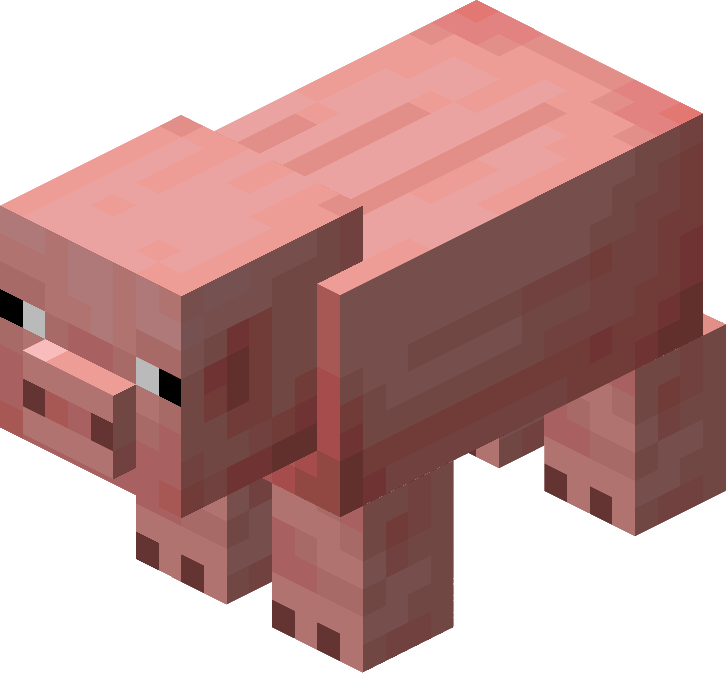
Pigs drop pork chops when killed, which originally served as the primary source of healing in the game. If a pig is struck by lightning during a thunderstorm then it will become a zombified piglin; a mob otherwise only found in the hell underworld of the Nether. Saddles can be placed on pigs, allowing the player to ride on their back, however their movement can only be controlled using a carrot on a stick.
Chickens
Chickens can be killed for feathers; feathers are used to make arrows. If left alive, however, chickens can leave eggs on the ground. Since the beta 1.8 Adventure Update, chickens drop raw chicken when killed which can be cooked in a furnace.
Sheep
Originally sheep could be punched with any non-tool to shear them for 1-3 blocks of wool. After Beta version 1.7, however, punching sheep only hurts them. Instead, sheep must now be trimmed using shears which harvest 1-3 wool per sheep, with wool regrowing when a sheep eats grass.
Squid
Introduced in Beta 1.2, these mobs spawn only in water, and slowly suffocate if pushed onto land. While these animals are completely peaceful, they can be killed to gain ink packets, which can be turned into black dye. As of Java Edition 1.17, a variant known as glow squids will sometimes spawn, dropping glow ink sacs, which can be used to make certain blocks glow.
Villagers

Villagers are the NPCs who spawn in procedurally-generated villages. Originally they were meant to have names, though every last one of them had "Testificate" in their name plate -- a nickname that has stuck with them since their inception.
Villagers can be given jobs using special blocks, although some will generate already having jobs, due to villages generating said blocks. Once a villager is employed, they will trade with the player, offering various items in exchange for emeralds, as well as vice versa. Villagers' perception of the player is improved upon trading or otherwise helping them, however, attacking a villager will decrease their perception of the player. A village's perception of the player will impact the prices offered when trading.
Villages are common targets for attack, with zombies attacking at night to turn villagers into zombie villagers, and illagers attacking at certain times to destroy the village. During either event, villagers will run into the nearest house, seeking shelter. If a village is large enough it may attract an iron golem, which will fight hostile enemies automatically, defending the village.
A variant of the villager, known as the wandering trader, will sometimes spawn near the player. The wandering trader spawns with two llamas, and will offer random trades to the player for one in-game day, before disappearing at night.
Neutral Mobs
These mobs will leave the player alone until provoked. The action causing provocation and the behavior of the mobs after they have been provoked differs between mobs.
Piglin
Only found in the nether, adult piglins will attack the player on sight, unless they are wearing a piece of golden armor. Adult piglins wield golden swords and crossbows, however baby piglins lack weaponry, and will not attack the player whatsoever. Additionally, piglins will attack the player if the player attacks a piglin, or touches a block which contains items or gold. Piglins can be given gold ingots, at which point they will give the player a random item, even if they were previously hostile towards the player.
Zombified Piglin
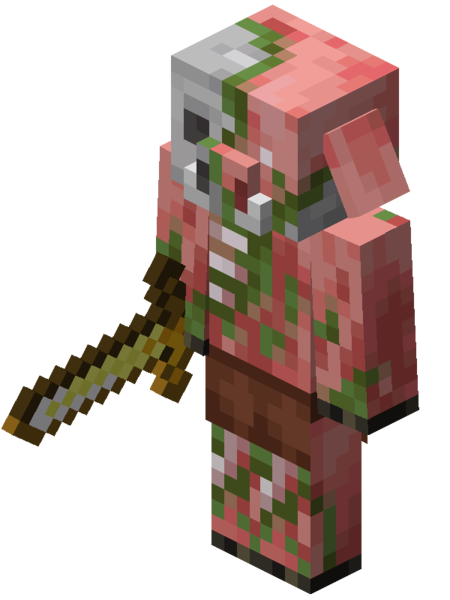
Only found in the Nether, zombified piglins are peaceful with the player and will not attack unless provoked. They passively wander around and make sounds crossed between pigs and zombies. They become hostile and make loud angry shrieks when attacked or damaged, at which point any other zombified piglins in the area will also become hostile. A group of zombified piglins will generally overwhelm a single player. They wield Golden Swords and drop rotten flesh and gold nuggets upon death. They were originally zombie pigmen, however they were changed to be zombified piglins in Java Edition 1.16, with the introduction of piglins.
Wolves
Introduced in Beta 1.4, wolves are the game's first tameable pet. They can be tamed by feeding them 5-6 bones. Once tamed, hearts will appear and a red collar is present on their neck. The player can tame more than one. The wolves will follow the player character and teleport to them if they get too far away. If the player right-clicks on them they will sit, and if the player feeds them pork chops they will regain health. Their health meter is represented by their tail (vertical tail is full health, lowered is low health). They will attack any players or mobs that the player character attacks, and defend them. Mobs will not attack them. In the wild they are neutral but will attack if provoked. They are somewhat rare but commonly found in forest-type areas.
Ocelots
Introduced in Full Release 1.2, ocelots only spawn in jungle biomes, and purposely hunt down and kill certain passive mobs nearby. Ocelots scare easily and will flee at high speeds (the only mob currently capable of sprinting) if the player moves or even looks around too suddenly near them, but will readily approach if the player holds raw cod or salmon in their hand. Feeding the ocelot will cause it to become trusting of the player, at which point it will no longer flee from them. Ocelots scare away creepers, and are immune to fall damage, but will not stick by the player's side like wolves do.
Cats
Originally obtained by taming an ocelot, cats became their own mob in Java Edition 1.14, spawning near villages and behaving similarly to ocelots. Cats are tamed in the same way as trust is gained with ocelots, but can be leashed before taming. Similarly to ocelots, cats are immune to fall damage and scare away creepers, as well as phantoms. There are 11 variants of cat, each based on real-life cat breeds, however the differences between them are purely visual.
Horse

Added in Full Release 1.6, horses are another tameable mob, such as wolves and cats. Horses are tamed by feeding them certain food items, or by attempting to ride on their back enough times. Once tamed, the player can put a saddle on the horse to ride it around, providing a faster means of transportation than walking. Horses can also be equipped with horse armor, protecting them from attacks. A variant of horses, the donkey, can also spawn. Donkeys can not be given horse armor, and are slower than normal horses, however they can be equipped with chests, allowing for easy transportation of large quantities of items. If a horse is bred with a donkey, the resulting offspring will be the otherwise unobtainable mule, which behaves like a donkey, albeit with a more wildly varying run-speed. Mules can not be bred with any other animal, even other mules.
Llama
Added in Full Release 1.11, Llamas function similarly to horses, donkeys, and mules, although they move slowly on their own, and can not be directed through riding. Instead, llamas are useful for carrying items long distances, accomplished by equipping them with a chest and items, and then leading them along with a lead. If one llama is led with a lead, nearby llamas will follow suit. If a llama or their owner are attacked, every nearby llama will spit at the attacker, damaging them slightly.
Enderman
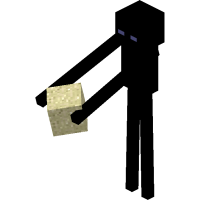
A slight reference to the popular internet creepypasta Slender Man, endermen were added in Beta 1.8. Technically neutral, endermen will slowly wander around, picking up blocks and moving them around (making them the only mob capable of directly interacting with the world's blocks, apart from creepers destroying them with explosions). However, if the player attacks an enderman or looks directly at one, it will become hostile and attack. Endermen have the ability to teleport about once a second.
Endermen are especially abundant in the End, where they are one of the only inhabitants.
When killed, endermen drop ender pearls, an item which the player can throw to teleport a distance, at the cost of a small amount of health. Occasionally upon use, an ender pearl will spawn an endermite, a small hostile mob.
Iron Golems
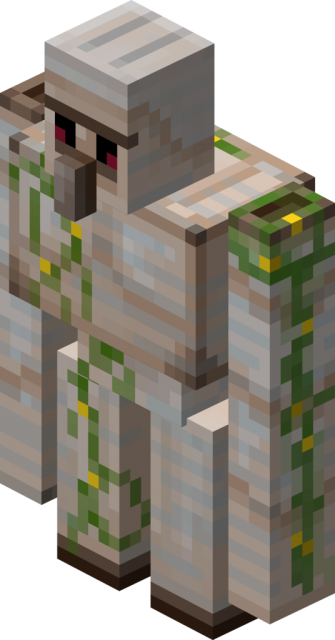
Introduced in Full Release version 1.2, Iron Golems are automatons created by the villagers to protect them from zombies and illagers. Incredibly powerful, with high health and a strong attack, golems are completely harmless to the player unless deliberately provoked. On occasion, iron golems will approach villager children and present them with roses, a reference to a scene from the film Castle in the Sky. Although they will automatically engage zombies and illagers upon detecting them, iron golems will also do battle with any mob that damages a villager in it's vicinity. They will also protect the player in this manner, making them handy to have around. The player can also construct their own golems, using iron blocks and a jack o'lantern.
Hostile Mobs

Spawning only in poorly lit areas (such as during the night, or when underground), hostile mobs readily attack the player when they get near. Each enemy type has its own special traits, and can be damaged with any item, however, items specifically intended as weapons (such as axes, swords, bows, and crossbows) are the most effective ways of combatting them.
Zombie
The most basic of enemies, zombies are slow and moan incoherently. They can only attack from a close proximity, and will slowly walk toward the player once they see them. Zombies ignore any non-player mobs nearby with the exception of villagers, wandering traders, and iron golems, who they will attack. Villagers killed by zombies turn into zombie villagers (although zombie villagers can also occur naturally), but can be cured with a potion of weakness and a golden apple. Aside from zombie villagers, three variants of zombies exist: chicken jockeys, husks and drowned. Chicken jockeys are rarely spawning baby zombies which ride on the back of chickens. Husks only spawn in deserts, and behave much like normal zombies. Drowned spawn in water, or when a normal zombie is underwater for too long. Naturally spawning drowned have a small chance to spawn with a trident, the only natural way of obtaining one in the game. Only normal zombies, zombie villagers, and chicken jockeys will catch on fire in direct sunlight, as husks are adjusted to hot desert climates, and drowned do not leave the water. When killed, zombies drop rotten flesh, with a rare chance to drop farming materials or iron ingots.
Skeleton
Skeletons are ranged opponents; only getting close enough to fire arrows at the player. Their movement patterns often involve circling the player as they get closer. Skeletons make a bone-clattering sound, but are more often identified by the sounds of their arrows being fired. Three variants of skeleton exist: spider jockeys, strays, and wither skeletons. Spider jockeys are skeletons which ride on the back of spiders, granting them faster movement speed than normal skeletons. Strays only spawn in snowy biomes, and fire arrows which inflict slowness upon the player. Wither Skeletons only spawn in Nether fortresses, and wield swords rather than bows. Wither Skeletons drop wither skeleton heads, a requirement for summoning The Wither. Skeletons drop bones and arrows when killed and all variants catch fire in direct sunlight, except for Wither Skeletons, who are immune to fire.
Spider

Spiders are dangerous foes, due to their ability to climb sheer walls. They move somewhat slowly but leap at the player once they are in range to do so. They are also only a single block tall but two blocks wide, allowing them to slip under narrow gaps. They make loud hissing noises and have no footsteps. Spiders are docile during the daytime, but will still attack if attacked first. A spider that becomes hostile to the player during the night will remain hostile to the player even once the sun rises only giving up once the player dies or it does. They have one variant, the cave spider. Cave spiders only occur undeground in mineshafts, and behave like a regular spider. Unlike regular spiders, however, cave spiders are smaller, and poison the player upon attacking. Both spiders and cave spiders drop string and spider eyes when killed.
Creeper
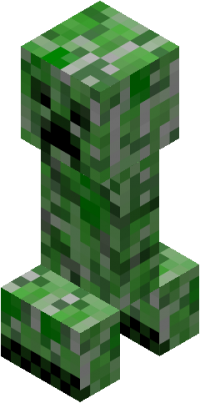
Creepers are easily the most iconic mob in Minecraft, and are among the most dangerous. They have movement patterns almost identical to zombies, but Creepers make absolutely no noise unless within attack distance, at which point they will make a loud hissing noise (similar to lighting the fuse of an old-fashioned bomb), at which point they swell up and explode. This leaves the player about one second to get out of the blast radius, or to hit the creeper out of distance. The explosion is 75% the strength of TNT, and like TNT it destroys blocks around it and does less damage the further the player character is from the epicenter. If the player can distance the creeper from themself quickly enough, it will not explode, but will continue approaching the player until killed. Creepers drop gunpowder when killed by normal means but will not drop anything if they detonate. They also drop a vinyl record if they are killed by a skeleton's arrow. If a lightning bolt strikes near a creeper, they will become electrified and supercharged, causing their explosion to be much larger and much more powerful, often enough to kill a player in one hit. Creepers do not burn up in direct sunlight.
Illager
Illagers are evil versions of villagers, typically found in woodland mansions, illager outposts, or in raiding parties attacking villages. Visually similar to villagers, albeit with gray skin and different clothes, illagers are strong enemies which will attack the player on sight, and can destroy entire villages if not stopped. There are three types of illager: Pillagers, Evokers, and Vindicators. Pillagers carry crossbows and occur in raiding parties which attack villages every so often. Evokers have no weapon, instead casting various spells to attack their targets. Vindicators appear passive at first glance, however they will pull out an axe and begin running towards their target whenever they approach. Evokers and Vindicators both spawn naturally in woodland mansions, as well as spawning during later waves of village raids. Code for a fourth type of illager, the Illusioner, exists in the Java Edition of the game, however it is not present in the game itself except through use of commands or modifications.
Phantom
Phantoms are a special mob, only spawning when the player has not slept for three or more in-game days. They spawn in the sky above the player, circling overhead before swooping down to attack. They continue to spawn until the player rests in a bed, although they will catch on fire in direct sunlight. Upon death, phantoms sometimes drop phantom membranes, which can be used for powerful potions and repairing rare items.
Slime
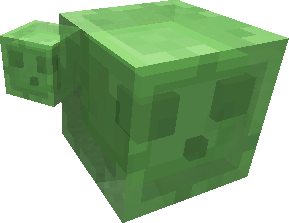
Slimes are a rare enemy that only spawn deep underground in specific chunks of the world, or in swamps. Their attack is similar to a spider's, as they simply jump towards the player, albeit not as ferociously. Slimes can spawn in various sizes, and split apart when attacked. The smallest slimes cannot do damage to the player, but will still follow them around. They also can only move around by jumping making plopping sounds as they land. When killed they drop balls of green slime, which can be used to create sticky pistons and a number of other items.
Guardian
Guardians are a type of oceanic mob which only spawn in ocean monuments. They attack from a distance, swimming around to avoid the player while staying close enough to attack them. Within the heart of ocean monuments exists a variant of guardian, the Elder Guardian, which has significantly more health, does more damage, and inflicts mining fatigue on all nearby players.
Magma Cube
Magma cubes are similar to slimes, although they only spawn in the Nether, where they occur almost everywhere. They sport more health than a slime, deal more damage, and even deal damage when at their smallest size, unlike slimes. They are also immune to lava. When killed they drop magma cream, which can be used for potions of fire resistance.
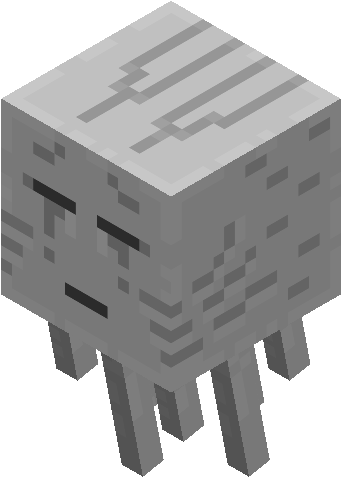
Ghasts
Found only in the Nether, ghasts are huge, floating creatures, characterized by their constant moaning when idle and blood-curdling screams when attacking. They launch explosive fireballs at the player that will destroy surrounding blocks, much like a creeper's explosion. It is possible to bounce the fireballs back at the ghast either by timing a hit on it with a sword or by shooting it with a bow and arrow. If a ghast manages to hit the player's portal to the real world with its fireball, the portal will close and will need to be re-ignited if the player wishes to leave. When ghasts are killed they drop gunpowder and ghast tears, valuable potion ingredients.
Originally, ghasts were intended to have a small chance of spawning near nether portals when the player returned to the overworld, however this was never implemented. In possible reference to this, there is a secret advancement for bringing a ghast to the surface, by drawing it through a nether portal.
Hoglin
Spawning in groups in the Nether's crimson forest biomes and in bastion remnants, hoglins are large, warthog-esque mobs. They attack players that get within 32 blocks of them, flinging the player into the air. If a hoglin somehow makes it out of the Nether, it will quickly zombify, turning into a zoglin. Upon death, a hoglin drops raw porkchops and leather, providing a valuable source of food in the Nether for those willing to pursue the dangerous mob.
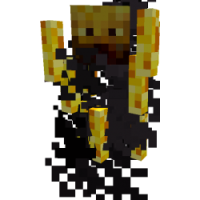
Blaze
Blazes are mobs found in the Nether, usually spawning from monster spawners inside of Nether Fortresses. Like most spawners, it will start spawning when the player comes within 16 blocks of the spawner. When a blaze notices the player, they will start flying and throwing fire charges at the player. When killed by the player they will drop Blaze rods, an item necessary for making potions, as well as for reaching The End.
Shulker
Shulkers are a special mob only found in End Cities, special structures spawning in the outer reaches of the End. They normally conceal themselves as purple boxes, but will pop out and attack upon a player's approach. Getting hit by one of their projectiles will cause the player to take damage, as well as levitate for a few seconds before falling back down. Killing a shulker will drop a shulker shell, a prerequisite for making shulker boxes, a special storage item allowing players to carry far more items in their inventory.
Boss Mobs
Boss mobs are unique even among hostile mobs, due to their massively increased health, more complex AI, and the greater requirements to find and fight them. When a player is near a boss mob, a health bar will appear at the top of the screen, showing how much health the boss still has. Only two currently exist.
The Ender Dragon

The Ender Dragon was the first boss mob introduced to Minecraft, added in the full release of the game. She can only be found in the End dimension, where she will spawn naturally upon a player's first arrival. The Ender Dragon flies around the main island of the End, occasionally swooping down to knock the player into the air, turning towards the player to shoot a fireball at them, temporarily burning the ground where the fireball lands, or flying towards a structure in the center of the island and stopping there briefly. As the Ender Dragon flies around, ender crystals positioned on the End's many obsidian towers will slowly regenerate her health, making it paramount that the player destroy the crystals before fighting the Ender Dragon.
Upon the dragon's death, the structure in the center of the End will complete itself, filling in with an inky void-like block, which when stepped in will show the player the game's credits and send them back to the Overworld. As well, an Ender Dragon egg with no functional use will appear atop the structure, and End gateways will appear at the outer rim of the island, allowing players to go to the far reaches of the End. The dragon can be resummoned by placing End crystals around the central structure, allowing it to be fought again. However, fighting it again will not spawn additional dragon eggs.
The Wither
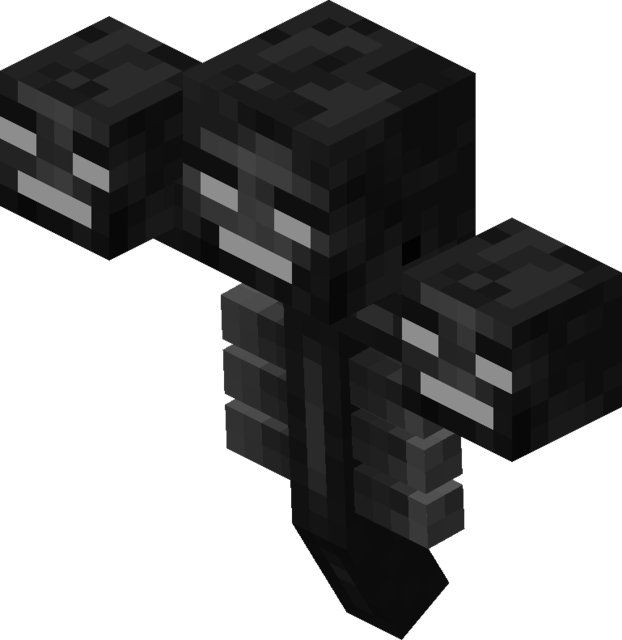
The second boss mob to be added to Minecraft, the Wither was introduced in Java Edition 1.4.2. The Wither is summoned by placing three Wither Skeleton skulls onto a T-shaped configuration of soul sand or soul soil, destroying the used items and spawning the Wither. When first spawning, the Wither is stationary for a moment as its health bar fills up, at which point it will explode, dealing damage to the surrounding environment and any nearby mobs, and make a sound audible to every player in the world, beginning the fight. The Wither tends to hover a few blocks above the ground, and fires exploding projectiles at all nearby mobs as it flies. In the Java Edition, getting the Wither below half health causes it to become immune to projectile damage, as well as flying closer to the ground. On Bedrock, it will create a sizable explosion, spawning three Wither Skeletons, and causing the Wither to take reduced damage for the rest of the fight.
Upon its death, the Wither drops a Nether star, an item required to create beacons, powerful structures which grant positive status effects to all players within a certain range.
Soundtrack
Most of the music and sound design for Minecraft was provided by Daniel "C418" Rosenfeld, however later expansion packs and updates would introduce a number of songs from other composers. Gareth Coker provided the music for every expansion pack made for the Bedrock Edition of Minecraft, while Lena Raine would provide four new songs (Chrysopoeia, Rubedo, So Below, and Pigstep), added in the 2020 Nether Update.
The game's soundtrack was released on March 4th, 2011, under the name Minecraft: Volume Alpha. The compilation contains a total of twenty-four tracks, ten of which do not appear ingame.
| No. | Title | Length | No. | Title | Length |
|---|---|---|---|---|---|
| 1. | Key | 1:05 | 13. | Wet Hands | 1:30 |
| 2. | Door | 1:51 | 14. | Clark | 3:11 |
| 3. | Subwoofer Lullaby | 3:28 | 15. | Chris | 1:27 |
| 4. | Death | 0:41 | 16. | Thirteen | 2:56 |
| 5. | Living Mice | 2:57 | 17. | Excuse | 2:04 |
| 6. | Moog City | 2:40 | 18. | Sweden | 3:35 |
| 7. | Haggstrom | 3:24 | 19. | Cat | 3:06 |
| 8. | Minecraft | 4:14 | 20. | Dog | 2:25 |
| 9. | Oxygène | 1:05 | 21. | Danny | 4:14 |
| 10. | Équinoxe | 1:54 | 22. | Beginning | 1:42 |
| 11. | Mice on Venus | 4:41 | 23. | Droopy Likes Ricochet | 1:36 |
| 12. | Dry Hands | 1:08 | 24. | Droopy Likes Your Face | 1:57 |
The second official soundtrack was released on November 9th 2013, under the name Minecraft: Volume Beta. The album featured 30 full tracks which added new music to the game's menus, creative mode, the Nether and The End dimensions, and the music discs added to the game in Full Release 1.0.0.
The album features a song named 'Taswell', named after late Giant Bomb employee Ryan Davis.
| No. | Title | Length | No. | Title | Length |
|---|---|---|---|---|---|
| 1. | Ki | 1:32 | 16. | Taswell | 8:35 |
| 2. | Alpha | 10:03 | 17. | Beginning 2 | 2:56 |
| 3. | Dead Voxel | 4:56 | 18. | Dreiton | 8:17 |
| 4. | Blind Spots | 5:32 | 19. | The End | 15:04 |
| 5. | Flake | 2:50 | 20. | Chirp | 3:06 |
| 6. | Moog City 2 | 3:00 | 21. | Wait | 3:54 |
| 7. | Concrete Halls | 4:14 | 22. | Mellohi | 1:38 |
| 8. | Biome Fest | 6:18 | 23. | Stal | 2:32 |
| 9. | Mutation | 3:05 | 24. | Strad | 3:08 |
| 10. | Haunt Muskie | 6:01 | 25. | Eleven | 1:11 |
| 11. | Warmth | 3:59 | 26. | Ward | 4:10 |
| 12. | Floating Trees | 4:04 | 27. | Mall | 3:18 |
| 13. | Aria Math | 5:10 | 28. | Blocks | 5:43 |
| 14. | Kyoto | 4:09 | 29. | Far | 3:12 |
| 15. | Ballad of the Cats | 4:35 | 30. | Intro | 4:36 |

 Mac
Mac Xbox 360
Xbox 360 PlayStation 3
PlayStation 3 Xbox 360 Games Store
Xbox 360 Games Store.png) PlayStation Network (PS3)
PlayStation Network (PS3) PC
PC iPhone
iPhone iPad
iPad Android
Android Windows Phone
Windows Phone PlayStation Vita
PlayStation Vita Wii U
Wii U Browser
Browser.png) PlayStation Network (Vita)
PlayStation Network (Vita) Xbox One
Xbox One PlayStation 4
PlayStation 4 New Nintendo 3DS
New Nintendo 3DS

